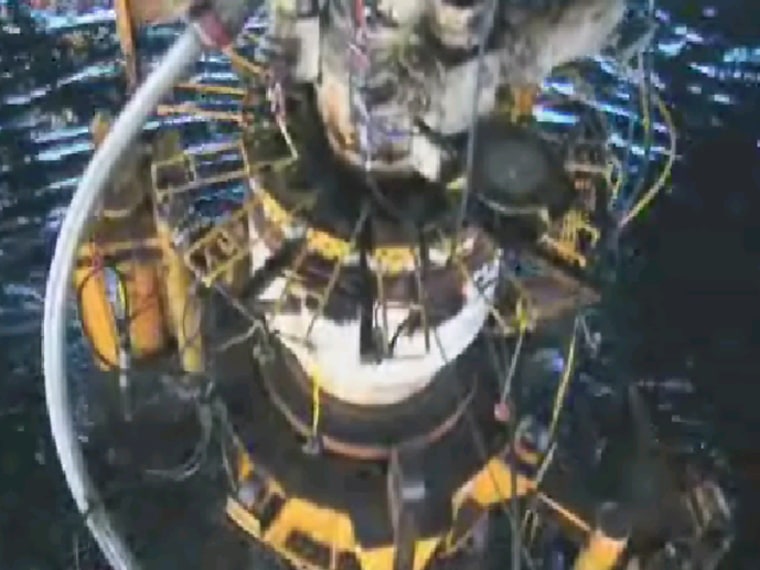Investigators looking into what went wrong in the Gulf of Mexico oil spill are a step closer to answers now that a key piece evidence is secure aboard a ship.
Engineers took 29½ hours to lift the 50-foot, 300-ton blowout preventer from a mile beneath the sea. The five-story high device breached the water's surface at 6:54 p.m. CDT and looked largely intact with black stains on the yellow metal.
FBI agents were among the 137 people aboard the Helix Q4000 vessel, taking photos and video of the device. They will escort it back to a NASA facility in Louisiana for analysis.
The blowout preventer was placed into a metal contraption specifically designed to hold the massive device at 9:16 p.m. CDT Saturday.
The top U.S. official overseeing the spill response said Saturday that the ruptured well would not spew any more oil into the sea.
"We basically have secured this well," retired Coast Guard Admiral Thad Allen said. "We have essentially eliminated the threat of discharge from the well at this point."
On Friday, BP replaced the failed equipment with a new giant stack of valves and pipes. Once the new blowout preventer is tested, BP can resume drilling a relief well that will bore into the Macondo well and pump in mud and cement to plug it for good.
"We should be ready to move forward with the relief well sometime next week," Allen said.
Crew members were silent as the failed preventer was maneuvered into place on the ship, water dripping off the device.
They had been delayed raising the device after ice-like crystals — called hydrates — formed on it. The device couldn't be safely lifted from the water until the hydrates melted because the hydrates are combustible, said Darin Hilton, the captain of the Helix Q4000.
Hydrates form when gases such as methane mix with water under high pressure and cold temperatures. The crystals caused BP problems in May, when hydrates formed on a 100-ton, four-story dome the company tried to place over the leak to contain it.
Light sheen
As a large hatch opened up on the Helix to allow the blowout preventer to pass through, several hundred feet of light sheen could be seen near the boat, though crews weren't exactly sure what it was.
The April 20 explosion aboard the Deepwater Horizon killed 11 workers and led to 206 million gallons of oil spewing from BP's undersea well.
Investigators know the explosion was triggered by a bubble of methane gas that escaped from the well and shot up the drill column, expanding quickly as it burst through several seals and barriers before igniting.
But they don't know exactly how or why the gas escaped. And they don't know why the blowout preventer didn't seal the well pipe at the sea bottom after the eruption, as it was supposed to.
While the device didn't close — or may have closed partially — investigative hearings have produced no clear picture of why it didn't plug the well.
Leak, low battery
Documents emerged showing that a part of the device had a hydraulic leak, which would have reduced its effectiveness, and that a passive "deadman" trigger had a low, perhaps even dead, battery.
Steve Newman, president of rig owner Transocean, told lawmakers following the disaster that there was no evidence the device itself failed and suggested debris might have been forced into it by the surging gas.
There has also been testimony that the blowout preventer didn't undergo a rigorous recertification process in 2005 as required by federal regulators.
Testimony from BP and Transocean officials also showed that repairs were not always authorized by the manufacturer, Cameron International, and that confusion about the equipment delayed attempts to close the well in the days after the explosion.
A Transocean official has said he knew the blowout preventer was functioning because he personally oversaw its maintenance, and he said the device underwent tests to ensure it was working.
The device, he said, had undergone a maintenance overhaul in February as it was being moved to the Deepwater Horizon to be placed over BP's well.
Also, according to testimony, a BP well site leader performed a pressure test April 9 on the blowout preventer, and he said it passed.
Some have cautioned that the blowout preventer will not provide clues to what caused the gas bubble. And it is possible a thorough review may not be able to show why it didn't work.
That could leave investigators to speculate on causes using data, records and testimony.
Lawyers will be watching closely, too, as hundreds of lawsuits have been filed over the oil spill. Future liabilities faced by a number of corporations could be riding on what the analysis of the blowout preventer shows.
A temporary cap that stopped oil from gushing into the Gulf in mid-July was removed Thursday. No more oil was expected to leak into the sea, but crews were standing by with collection vessels just in case.
The government said a new blowout preventer was placed on the blown-out well late Friday.
